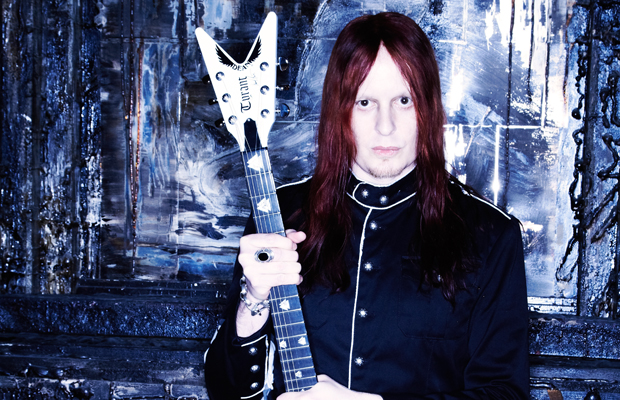
Tuesday, June 7, marks the release of the first new album of original material from Sweden’s Arch Enemy in almost four years. Guitar World recently caught up with Arch Enemy guitarist Michael Amott about the band’s new album, Khaos Legions.
GUITAR WORLD: It’s been four years since the last Arch Enemy album, but in 2009 you released The Root of All Evil, which saw the band re-recording tracks from your first three albums. Do you think revisiting your older material had an impact on the new album?
MICHAEL AMOTT: It probably had some effect. I hadn’t thought too much about that, but it probably did. You know how everything you do and all those experiences turn up later on. I think it was kind of cool. On The Root of All Evil, we kind of covered ourselves from the first three records. It was cool for me and Chris [Amott, Arch Enemy guitarist] to go back and revisit those guitar arrangements and try to figure it all out.
Some stuff it was like, “Wow, this was cool; we should do stuff like this again!” And some stuff was like, “This kind of sucks” [laughs]. So it was obviously interesting.
Have you guys been writing for the new album since the last all-original album?
Yeah, since 2007, absolutely.
This album might be your most consistent one. Do you think letting the songs gestate for three or four years is the reason for that?
Get The Pick Newsletter
All the latest guitar news, interviews, lessons, reviews, deals and more, direct to your inbox!
Probably. Usually we kind of come out of a world tour on a Friday and start pre-production for the next album on a Monday [laughs]. That’s how it’s been for 10 years for us, pretty much.
We definitely had more time, but we’ve been on the road a lot as well. We tour like crazy. We actually learned something, which is how to write on the road. You know, just capture little riffs, licks, little melodic ideas, chord progressions or whatever. We’ve been able to capture those ideas and save them for later. And we just got really into that routine.
We didn’t really get that year to write material. That doesn’t really happen, so we just got in the routine these last few years of writing on the road.
That sounds really serious, but really it’s just me and my brother backstage jamming, improvising something and then saying, “That’s really cool. Let’s record that real quickly.”
How did all those ideas start to come together when pre-production time rolled around?
When we actually started pre-production for the new album in the summer of last year, we just started trying to piece all these things together into proper songs. It was kind of like a heavy metal jigsaw puzzle! [laughs]
We just had a lot of material this time, so that’s why you have the variety.
The album kicks off with a couple of faster tracks, like “Bloodstained Cross” and “Yesterday Is Dead And Gone.” Then there’s something like “Under Black Flags We March,” which is more plodding …
Yeah, that’s like our Judas Priest bastard child. If we had a melodic thing around that, then it’d be straight-up heavy metal. But, uh, fortunately we don’t. [laughs]
We have a lot of melody with the guitars and a lot of aggressive riffs as well. We have these extreme dynamics where we go from aggressive, heavy, fast, brutal riffing to some very sweet, kind of emotional guitar lines. Then when Angela sings on top of it all, it just sounds like Arch Enemy.
Talk a little bit about your songwriting process for Khaos Legions. You’re the main songwriter in the band, correct?
I’m the main contributor of music, but I don’t really write full songs. I just bring a bunch of riffs to rehearsal and we do it the old-school way.
It seems like every time I read an interview with a band nowadays, they’re talking about the latest software they have, and how much easier that made it for them to complete an album. How everyone can email each other files and stuff. We don’t do it like that at all! [laughs] We just get in our rehearsal room and play too loud for hours on end. I started my first band when I was 14, and I’m still doing it the same way. [laughs]
That’s what I really get out of it, the give and take, the communication that you have with other musicians and the music you create together takes it to the next level. Hopefully. When you get it right. [laughs]
Was there anything different about the creation of Khaos Legions compared to your other albums?
We spent a lot more time on this album, and we engineered a lot of it ourselves. We worked and Angela tracked the vocals in another studio, a smaller studio that she had access to around the clock so she could go in and scream when she was angry in the middle of the night. [laughs]We had a good way of working on this album. We gave ourselves a lot of time, but in the end we were right up against the deadline with the delivery date.How much material did you record for this album?We actually recorded, I think, 21 pieces of music for this album. There were, I think, three cover tunes, and then some instrumental pieces that aren’t mixed yet. I think we might put that out as an EP later this year or the beginning of next year.You’re known for bringing a lot of guitars in the studio with you when recording. Were there any on this record that you found yourself really coming back to?You know what? You’re never going to believe this, but I actually used my Dean signature model [the Michael Amott Signature Tyrant Bloodstorm], the one that I play live a lot. That’s the one I tracked all the rhythms on.I brought in some other guitars, some Les Pauls and stuff. I wanted to play my signature model guitar on the album, but a lot of times when you bring in your favorite guitar, the engineer or the producer will say, “You know what, that guitar is really cool to play, but actually this guitar sounds better.”Then you’re like, “Fuck, now I have to fight with this big fat old …” [laughs] But actually this time my signature guitar sounded the best, so I was really happy about that. I had a lot of fun playing it because that guitar fits my hands really well.What did Chris use to track his rhythms?My brother used my signature guitar for his rhythm parts as well. We had to stick to one guitar for the rhythms because we tracked four rhythm tracks and we didn’t want to get into any tuning or intonation issues. Then to get different tones, we used various amps and different cabs instead of different guitars.You’ve long been known as a Randall guy as far as amps go, but I know you and Chris have been playing Marshalls live a lot lately. What sort of amps made their way onto the new record?For rhythm tracks, is was the Marshall JVM410 with a Maxon Tube Screamer in front of it, and that is pretty savage sounding!For my solos, that was kind of an elaborate set-up, actually. I used a vintage Marshall JCM800. It’s got a very warm sound, a really human sound, if you know what I mean. It’s not this fizzy, nasty distortion. I wanted a really classic lead guitar sound like Michael Shencker or somebody like that. A really nice, sweet tone, and I think you can’t beat the older Marshalls for that.What about effects?I’ve got a signature wah now with Home Brew Electronics, a small company from Arizona, and we’ve been working on a signature wah and this one is really, really good. Otherwise I don’t use that much else. All the echoes and delays are just this old Rockman half-rack unit. For the cleans we had an old Roland Jazz Chorus.Did you add any effects in ProTools during the mixing process?We didn’t add any other effects in ProTools so we tracked all those effects, like the MXR Phase 90 on my solo on “Bloodstained Cross.”That might surprise some people who think of Arch Enemy as a pretty high-tech band.From what I’ve read, it seems people have this idea that we’re kind of like this really high-tech band, but actually we’re pretty old school in our approach to gear. We don’t use active pickups like most bands in our genre. It seems like everyone is using them, but I find them to be too linear in tone for me. They’re great for rhythms, but when it comes to the leads, I like to hear more. I don’t know, it’s something … something in the air. [laughs]Look out for an edition of "The Inquirer" with Michael Amott in the August issue of Guitar World.
Josh Hart is a former web producer and staff writer for Guitar World and Guitar Aficionado magazines (2010–2012). He has since pursued writing fiction under various pseudonyms while exploring the technical underpinnings of journalism, now serving as a senior software engineer for The Seattle Times.
“I heard the Money solo and thought, ‘This is amazing!’ So I sent David a telegram saying, ‘Remember me? I'm in a band now called Roxy Music’”: Phil Manzanera on his friendship with David Gilmour, and the key to the Pink Floyd man's unmistakable tone
“It’s really quite genius, but also hard to learn – it sounds insane, but sometimes the easiest songs still get me nervous”: Kiki Wong reveals the Smashing Pumpkins song she had the most trouble with











